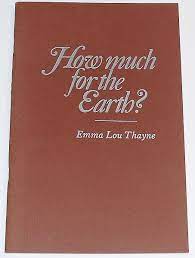Articles/Essays – Volume 23, No. 2
Passion Poems | Emma Lou Thayne, How Much for the Earth?
One might suspect that a book of poems published by Utahns United Against the Nuclear Arms Race might possess as interesting a history as the poems that comprise it. How Much for the Earth? by Emma Lou Thayne entered its third printing in English in 1989 with translations already available in German and Russian. Proceeds from this printing and from a Kiev, USSR, publisher go into separate funds for peace.
This volume, carried in the hand of its Utah-born, Mormon author, opened doors as no visa can during her recent visit to the Soviet Union. There poets are read by the people, not only by the literatae. Passion and even propaganda have their place, for poems and poets speak for the times, as happened here during the Vietnam War and, with less recognition, during the women’s movement.
In this “Suite of Poems: About Time for Considering,” Thayne is as accessible and intimate as readers of her earlier col lections might expect. For the first time, she is as overtly political as overtly per sonal. This slim volume traces her own journey from a high school physics class, through the nuclear victory of World War II, to a realization of the mushroom shaped shroud that overhangs our planet. In one poem we witness the birth of a grandchild and in another meet a visitor to Dachau, indelibly etched on our memo
He stares without motion
involved as a lover
awaiting a lover in a crowd. Like
a camera his gaze inches
from end to end of the barracks,
returns, returns
to the door. It is more than a
memorial he is attending.
The building keeps everything; it
remembers.
He listens to its voice with a look
of such sadness
I want to touch it away. Who
might have known I could be
so held by what passes between a
stranger and the years,
him searching for a day and find-
ing it?
In this collection, Thayne’s poetic voice entices us as storyteller, prophet, cajoler, and exhorter. Form, image, and statement merge and meld with scarcely a seam. Here, too, even writing the possibility of ultimate destruction, she celebrates life with the vibrancy of her other works:
Smell of soap, hot animal. An
apple crisp. A ball hit,
Tongue of a lover, dream of a dead
mother stroking our cheek.
These poems remind us that the per sonal and the political are inextricably intertwined; that none of us can sit out the dance of life and expect it to indefinitely continue.
How Much for the Earth? by Emma Lou Thayne (Salt Lake City: Utahns United Against the Nuclear Arms Race, 1989), 24 pp.


 Back to full Issue
Back to full Issue

